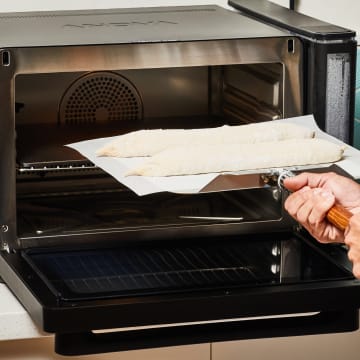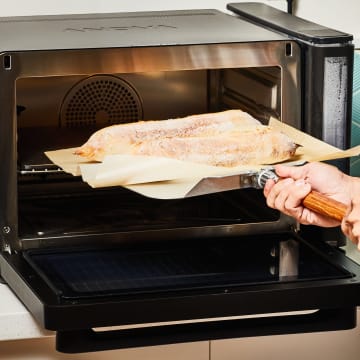Steam-Baked Demi-Baguettes

Andrew Janjigian
October 17, 2022
Let’s face it: Baguettes are a challenging bread to pull off consistently well, especially for a beginner. But one of the challenges to making a great home-baked baguette is made easy by using an Anova Precision Oven, which has the ability to quickly fill with steam. Surrounding the baguettes with steam during the first few minutes of baking ensures proper oven spring, scores that expand fully, and a crisp, well-browned crust.
This recipe uses a long-fermented, nearly no-knead approach for a dough with great flavor and a silky, easy-to-handle texture. It uses bread flour, along with 10% whole wheat flour, for a boost of wheaty flavor and a tan-hued crumb. It also calls for a small amount of diastatic malt powder, a natural enzyme that helps promote the conversion of starch into sugars, driving fermentation and ensuring proper caramelization of the crust during baking. (This is a specialty item that can be found online from baking supply companies like Breadtopia.com; be sure to use *diastatic* malt, not malt sugar or syrup, which are sweeteners.)
Baguettes also call for a few specialty tools as well: A couche, which is a thick linen cloth (at least 17 inches wide and 24 inches long) used to cradle the loaves as they proof; a transfer peel (also known as a flipper board) for moving the baguettes from the couche to the baking peel; and a curved-blade lame for scoring the loaves. (You’ll also need a baking peel, a 16- by 12-inch sheet of parchment paper, a clean plastic garbage bag, and a baking stone or steel.)
This recipe yields two 225g home-sized demi-baguettes.
Serves
2
Prep Time
15:20
Cook Time
00:20
4.67 (3)
1844
Ingredients
240 g (2 cups)
bread flour
28 g (1/4 cup)
whole wheat flour
5.6 g (1 tsp)
fine salt
2 g (1/2 teaspoon)
instant yeast
½ g (1/8 tsp)
diastatic malt powder (optional)
195 g (3/4 cups plus 1 tablespoon)
lukewarm (75˚F) water
Steps
1. Mix Dough
Place the flours, salt, yeast, and diastatic malt (if using) in a medium bowl and whisk to combine. Place the water in a large bowl. Add about 1/4 of the flour mixture and whisk until uniform. Add the remaining flour mixture and stir with a dough whisk or knead in the bowl by hand until no dry flour remains. Cover and let rest 30 minutes.

2. Fold Dough
Using lightly-moistened fingertips, fold the dough over itself by gently lifting and folding one edge of the dough toward the center. Rotate the bowl slightly and repeat folding. Rotate the bowl and repeat folding until you can no longer easily stretch edge of dough, 6 to 8 times total.

3. Rest Dough
Transfer the dough to a lightly-oiled 8- by 8-inch cake pan and press gently to spread out as much as possible without forcing it. Cover and let rest until slightly less than doubled in volume, 60 to 90 minutes longer. Cover the dough tightly and refrigerate for 12 to 48 hours, depending upon your schedule.

4. Warm Dough
Remove the container from fridge and allow dough to warm up until just cool to the touch (between 50˚ and 55˚F), 30 to 45 minutes.
5. Preshape Loaves
Flour the top of the dough lightly but evenly (it should no longer be sticky to the touch). Flour an area of countertop at least twice as large as the pan. Using a bench scraper, gently detach dough from sides of the pan if needed. Invert the pan over floured area and then gently nudge the dough onto the counter without stretching it beyond its current dimensions. Flour the top of the dough lightly but evenly. Using the bench scraper, stretch dough as necessary to form an even square, then divide the dough into 2 equal rectangles of about 225g (8 ounces) each.
Using the bench scraper, slide one dough rectangle to the side, flouring the countertop as needed. Orient the remaining dough so that the short side faces the edge of countertop. Starting at the end of the dough farthest from you, gently fold dough into thirds like a business letter. Turn the log of dough 90 degrees, then gently fold the dough into thirds again. Pinch the seams closed. Turn the cylinder seam-side up, slide to one side, and repeat with the remaining dough.
Arrange the pieces in a rectangle separated by about 2 inches, cover with the inverted cake pan, and let sit for 30 minutes.
6. Prepare Couche
Center a couche over a rimless cookie sheet or rimmed baking sheet with its long edges aligned with the short edges of the pan, and dust the area of the couche above the pan liberally with flour.

7. Shape Baguettes
Set one piece of dough on a lightly-floured countertop, with the long edge facing the edge of countertop. Using a slightly cupped hand, gently compress the dough into a 7- by 3- to 4-inch rectangle. Fold the top third of the dough toward the center and press gently using your fingertips to seal the seam. Rotate the dough 180 degrees and repeat folding to form an 8- by 3-inch rectangle with a slight crease along its center where the seams overlap.
Place the thumb of your non-dominant hand at end of the crease to hold the dough in place, then fold the dough in half over your thumb, sealing the dough with the heel of your hand and moving your thumb as you work your way from one end of loaf to the other. (Do not seal the ends of the loaf.)
Cup one hand over the center of the loaf and roll it gently forward and back 3 or 4 times to compress the middle of the loaf slightly. Using both hands, starting at the center of the loaf and working outward toward the ends, gently roll dough into an even, 13- to 14-inch-long cylinder, repeating the motion from the center to the ends as needed. Roll the ends of the loaf under your palms to form defined points.
Transfer the loaf to the floured couche, seam side up. Form the edges of the couche into pleats along either side of the loaf and then cover the couche with loosely with a clean plastic garbage bag.
Repeat step 5 with the remaining piece of dough. Fold the loose ends of the couche over the loaves, then place the sheet inside the garbage bag. Fold the end of bag loosely under the sheet to enclose it fully.
8. Proof Baguettes
Let the loaves sit until about doubled in volume and the dough springs back slowly when poked gently with a fingertip, 45 to 90 minutes, depending upon ambient temperatures.

9. Preheat the Oven
Rack
Thirty minutes before loaves are ready if using a baking steel (or 1 hour if using a baking stone), place the stone or steel on the rack and heat the oven.
Sous Vide Mode: Off
Steam: Off
Temp: 482°F
Heat: Rear
10. Preheat the Baking Surface
Rack
Let the oven hold at it temperature for 15 minutes to heat the baking steel. If using a baking stone, increase the timer to 30 minutes.
Sous Vide Mode: Off
Steam: Off
Temp: 482°F
Heat: Rear
00:15 Timer
11. Pre-Steam the Oven
Rack
When nearly ready to bake the baguettes, start the 5 minute timer.
Sous Vide Mode: Off
Steam: 100%
Temp: 482°F
Heat: Rear
00:05 Timer
12. Score Loaves
When the timer rings, set a 16- by 12-inch sheet of parchment paper on the countertop with its short end facing the edge of the counter. Remove the sheet from the plastic bag and set it next to the parchment. Unpleat the couche to separate the loaves. Using a transfer peel, gently roll the first loaf away from the second one, inverting it seam side down. Hold the transfer peel alongside the inner edge of the first loaf, at a 45-degree angle to couche, then lift the opposite end of the couche in your other hand and use it to roll the loaf seam side up onto transfer peel.
Gently invert the loaf onto the parchment, seam side down, centered lengthwise and about 2 inches from the long edge of the parchment. Use the transfer peel and your hand to straighten the loaf as needed. Repeat with the second loaf, leaving 3 inches of space between the loaves.
Rotate the parchment so the long end faces the edge of the countertop. Using your non-dominant hand, gently pinch the end of one loaf between your index finger and thumb to anchor it in place. Holding lame in the opposite hand, concave side up, with handle oriented at a 30-degree angle to loaf, make a single, 1/4-inch deep slash along the centerline of the loaf, using a single, swift motion from end to end. Repeat with the second loaf.
13. Steam Loaves
Rack
Slide a pizza peel under the parchment and transfer the loaves to to the baking stone or steel. Start timer.

Sous Vide Mode: Off
Steam: 100%
Temp: 482°F
Heat: Rear
00:08 Timer
14. Rotate Loaves and Vent Steam
Rack
Using the pizza peel, remove the loaves from oven. Rotate the loaves from back to front and return to the oven. Continue to bake until deeply browned and crisp, 6 to 10 minutes.

Sous Vide Mode: Off
Steam: Off
Temp: 482°F
Heat: Rear
00:06 Timer
15. Cool and Serve
Remove the loaves from the oven and transfer them to a cooling rack. Let cool for at least 15 minutes before slicing and serving.
Baguettes are best served within a few hours of baking.

© 2013 - 2025 Anova Applied Electronics, Inc.